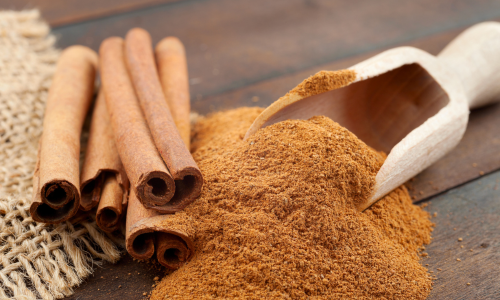The mere mention of cinnamon brings back fond memories of cozy winter evenings by a roaring fire, sipping on warm delicious drinks and enjoying sweet treats. Have you ever tried making a rich hot chocolate drink with ground turmeric, cinnamon and a pinch of cayenne pepper?
On a more practical note, cinnamon is more than just a delectable flavor. It has a long and fascinating history, dating back to ancient times, when it was highly valued for its medicinal properties.
What is cinnamon?
Cinnamon is a spice that has been used for centuries as a flavoring agent and medicinal herb, prized for its unique taste and aroma as well as its potential health benefits. Cinnamon is commonly used in cooking, baking and as a supplement in various forms, including essential oil, capsules and tea. It is known for its anti-inflammatory, antimicrobial and antioxidant properties (of which we will discuss just now) and has been traditionally used to treat a variety of ailments, including digestive issues, diabetes and respiratory infections.
What are the types of cinnamon?

There are several types of cinnamon. The most commonly used type of cinnamon is Cassia cinnamon (Cinnamomum cassia), which is also known as Chinese cinnamon. Another type is Ceylon cinnamon (Cinnamomum verum), also known as "true cinnamon." In actuality, there are more than 250 cinnamon tree varieties, though these are the two most common. Other types of cinnamon include Saigon cinnamon, Indonesian cinnamon and Malabar cinnamon. Each type has a slightly different flavor profile and aroma.
Cassia cinnamon is the more common variety that you find in the United States. It's harvested from the bark of the cassia tree, which is native to China and other parts of East Asia.
Cassia cinnamon has a strong, sweet flavor and is often used in baking and cooking. It's also used in traditional medicine for its various health benefits, including its ability to lower blood sugar levels and improve digestion.
On the other hand, Ceylon cinnamon has been prized for centuries for its sweet, delicate flavor and numerous health benefits. It contains lower levels of coumarin, a compound that can be toxic in high doses, compared to the more common Cassia cinnamon.
In the world of spice, Ceylon cinnamon is considered the gold standard, perhaps even the best. From adding a touch of sweetness to your morning coffee to improving insulin sensitivity, this remarkable spice has much to offer.
Where does cinnamon come from?

Cinnamon is believed to have originated from a perennial tree native to Sri Lanka (formerly known as Ceylon), a tropical island nation in South Asia. However, it is also grown in other countries such as Indonesia, China and Vietnam. The cinnamon tree can reach up to 45 feet in height. This tree is recognized for its aromatic, highly fragrant and versatile bark. The tree’s leaves and flowers are also highly fragrant and possess therapeutic properties.
Cinnamon spice is harvested by peeling off the inner bark of the cinnamon tree and allowing it to dry into long, thin strips that curl into the familiar cinnamon sticks. This can then be ground into cinnamon powder or used whole in cooking and baking.
The essential oil of cinnamon is extracted through steam distillation of the bark or leaves of the cinnamon tree, and it is used in aromatherapy, perfumes and other products.
Was cinnamon an expensive spice?
The rarity of cinnamon made it a symbol of great wealth and luxury, reserved only for the elite. It was imported from far-off lands, arriving from the Red Sea on "rafts with rudders, sails or oars" (according to the first century AD Roman historian Phily in an article by Fine DIning Lovers) and was highly valued for its unique flavor, aroma and medicinal properties. Phily also tells us that a pound cost 300 denarii, which was a year’s wage for a common laborer.
In ancient Rome, as in ancient Egypt, cinnamon was considered a very precious and prized commodity. To justify its high cost and maintain its exclusivity as a luxury item, elaborate stories about the dangers of obtaining it were devised. These included tales of giant birds that guarded the cinnamon trees and deadly snakes that infested such areas.
Seven benefits of cinnamon
The major components of cinnamon oil include cinnamaldehyde, eugenol and linalool. These components are responsible for many of the health benefits associated with cinnamon oil.
1. Aids in digestion
Cinnamon essential oil can help to soothe an upset stomach and promote healthy digestion. It can also help to relieve gas and bloating.
How to use: For digestion, add a drop of cinnamon essential oil to four fluid ounces of water and drink it before meals. For digestive spasms, indigestion or nausea, mix two drops with a carrier oil and apply directly to the stomach.
2. Reduces inflammation

Cinnamon essential oil contains cinnamaldehyde and eugenol, which have been shown to help reduce inflammation in the body. This can be especially helpful for those with conditions such as arthritis or other inflammatory disorders.
How to use: Dilute cinnamon essential oil with a carrier oil, (such as fractionated coconut oil, sweet almond oil or walnut oil), and massage it onto your joints to help reduce inflammation and pain. For topical application of cinnamon bark essential oil, a maximum dilution of 0.1% is recommended, as cinnamon bark is a "hot" oil and can cause skin irritation. For topical application of cinnamon cassia, 0.05% dilution is recommended. Do not use it when pregnant or breastfeeding.
3. Improves brain function
Cinnamon essential oil has been shown to improve cognitive function and memory. It can also help to improve focus and concentration.
How to use: Diffuse three to four drops in the diffuser of your choice while studying or working to help improve brain function. You can also sip cinnamon tea for improved memory function and attention span.
4. Promotes oral health
Cinnamon essential oil is considered both antimicrobial and anti-inflammatory, (as is clove oil), because of its active components—including cinnamaldehyde and eugenol. These compounds help to fight off harmful bacteria, fungi and viruses that can cause infections and illnesses. An article published by the National Library of Medicine suggests that cinnamon essential oil is the most effective in stopping streptococcus mutans, the main thug bug implicated with tooth decay. Cinnamon oil also helps to reduce swelling and redness associated with infections. Lastly, the oil's anti-inflammatory properties help to fight bad breath and tooth decay.
How to use: For an effective mouth rinse, add one drop of cinnamon oil to two ounces of water and gargle. In doing so, cinnamon oil can help to kill off damaging microorganisms and prevent them from causing further damage or spreading throughout the body.
5. Protects against diseases

Cinnamaldehyde has been found to have antioxidant properties. This means that it can help to protect the body from damage caused by free radicals, which are unstable molecules that can cause damage to cells and contribute to the development of various diseases, including infections, cardiovascular disease, diabetes, cancer and Alzheimer's disease.
How to use: According to the US Department of Health, "Cinnamon appears to be safe for most people when taken by mouth in amounts up to 6 grams daily for 6 weeks or less." Please consult a medical doctor who is qualified in Clinical Aromatherapy for more information.
6. Lowers blood sugar
Cinnamon oil has anti-diabetic properties. The polyphenols present in cinnamon oil, particularly cinnamaldehyde, are believed to be responsible for this effect. Studies have shown that cinnamon oil can help to lower blood sugar levels in people with diabetes, making it a potentially useful natural supplement for managing this condition. Cinnamon oil is thought to work by increasing insulin sensitivity, which can help to improve the body's ability to regulate blood sugar levels.
How to use: According to a National Library of Medicine article, "About one to six grams of these cinnamon species mainly in powder seems to be an adjunct drug treatment for type 2 diabetes mellitus and other conditions of glycemic impairment." This can either be as a supplement—in capsules or in powder form.
Note: Please note that I am not a medical doctor who is qualified in clinical aromatherapy.
7. Has relaxing properties
Linalool is a natural compound found in cinnamon oil that has been shown to have relaxing properties, which can help to reduce stress and anxiety.
How to use: Diffuse three to four drops in the diffuser of your choice, at home or your workplace, to help create a calming atmosphere.
How does Dr. Killigan use cinnamon?
That’s a most brilliant question. Knowing the tremendous strength of cinnamon and its plethora of benefits, understanding its power against insects was a must. Cinnamon has incredible insecticidal properties, making it a natural, safe and effective alternative to synthetic insecticides. According to a Cornell article on cinnamon, both cinnamon and cinnamon oils have demonstrated efficacy against various storage pests, including the rice weevil, flour beetle, grain borer and the maize weevil. Additionally, it "acts as a repellent to certain species of mosquitoes, and is used as an ingredient in various mosquito repellents—often in combination with other essential oils." Lastly, cinnamon oil has demonstrated 100% mortality "against the larvae of the cecidomyiid gall midge (Camptomyia corticalis), a pest of shiitake mushrooms."
The use of cinnamon as an insect repellent dates back to ancient times, when it was used to protect grains from pests. Today, cinnamon oil is commonly used to repel insects such as mosquitoes, ants and flies. Its strong aroma and chemical properties make it an effective deterrent, and it is often used in natural insect repellent sprays, candles and diffusers. In addition to being a safe and natural option, cinnamon oil is also environmentally friendly and does not harm beneficial insects or wildlife.
At Dr. Killigan’s, we use it as an ingredient, at 0.03%, in our safe, non-toxic spray Six Feet Under spray. This kill-on-contact spray eliminates ants, cockroaches, moths, houseflies, silverfish, weevils, fleas, ticks, mites, earwigs, aphids and more with the fastest kill times among competing brands. Its lab-proven, proprietary blend of select essential oils—which also include soybean and clove—break down bugs' exoskeletons and work synergistically to enhance effectiveness and absorption in insects’ systems.










